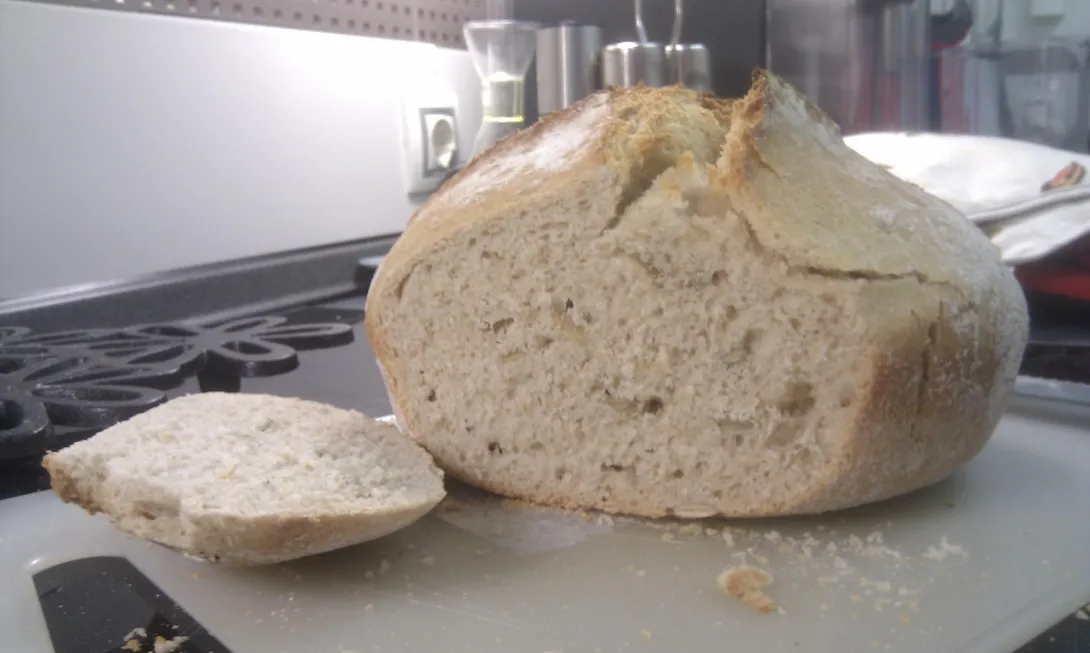
Pretty crust and excellent flavor, but I don't like the crumb's thickness.
I was undecided between two recipes and ended up using the one with 12h autolyse and 24h fermentation.
I don't know if the difference in crumb from my previous bread was because of:
- Using sourdough instead of yeast.
- Using 1/3 whole grain flour.
- Kneading poorly.
The problem I had with kneading is that the dough was too wet and sticky and I added more and more flour to be able to knead it but it never got really elastic and smooth. I'll have to learn more about how to interpret the dough's reactions and what to do in each case.
Can't tell much without it. Crumb texture looks heavy and dry. Most likely from the additional flour.
Need to learn how to deal with high hydration dough? The problem with adding too much flour while kneading is that it doesn't hydrate like the flour that was first mixed into the liquids. Post the recipe and we will check the hydration and possibly make some suggestions/tweaks for a lower hydration dough. You can then work more water into the recipe as your skills improve. :)
100% hydration starter: 150g
flour: 425g (1/3 whole grain) (not counting the kneading flour)
water: 300g
salt: 10g
1. mix flour and water into a lump of mass, cover and put in fridge for 12 hours.
2. add starter and salt to the dough, use hand to mix until roughly evenly distributed.
3. bulk rise at room temp (70 to 75F) for 2-3 hours until it grows about 1/3 in volume, Put in fridge.
4. 24 hours later, took it out, kneaded it and gave it ~2 hours to raise.
6. Shape and proof for 1h, score, baked at 230Cº in dutch oven covered until 95ºC and uncovered for 5 more minutes.
you might want to reduce to 65% or 70% to do that reduce the water to 250g for 65% or 275g for 70%
If 2/3 of the flour is AP, try the 65%. if you're using bread flour, try 265g and add more water a spoon at a time if needed to moisten all the flour. Sourdoughs tends to soften as they ferment so you might want to stretch and fold the dough over onto itself while it is chilling, retarding or fermenting.
Wait until it has a little bit of volume first then flip out the dough so it's upside down, stretch and pull out the sides gently and then fold over the rest of the dough mass. work from opposite sides North/South, East/West or go around the clock face. What ever you are more comfortable doing.
Flip the dough back over when done and tuck under any corners sticking out. Return to bowl, cover and let rise. Repeat when the dough appears to be too fluid or flat shaped.
Another source of "problem" could be that my sourdough is just 10 days old. It's thick and spongy after feeding and grows to twice its size every day but I don't know if it's too young, or something.
Or maybe I just used it wrong, not giving it enough time after feeding before mixing with the flour and water.
lid comes of i take it out of the DO and let it bake on a stone or right on the rack until it browns up about 5 -10 more minutes depending on the size of the loaf
When you take it out of the fridge do a quick gentle pre-shape using 4 stretch and folds (no kneading) and put back in the bowl covered. Then an hour later,do a gentle (no kneading) shape and let it prove to 50% (not 100%) - about 30 - 45 minutes depending on how active your levain is...watch the dough - not the clock.
This should give you more open crumb and much better crust color
For a young starter it turned out very well. That is quite a first loaf of SD for sure.
Well done and Happy baking
I'll follow these advice on today's bread.